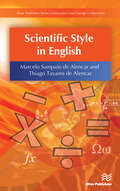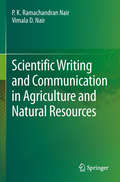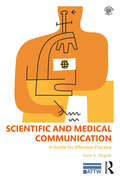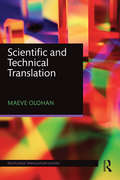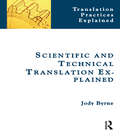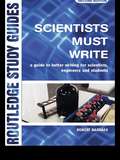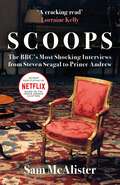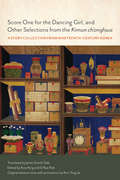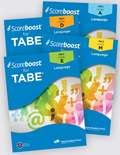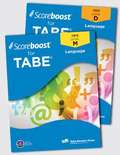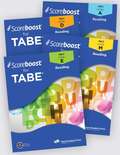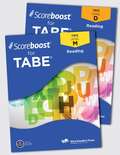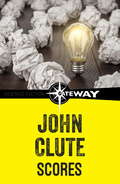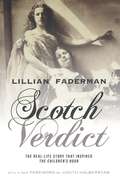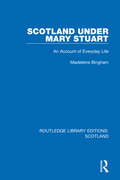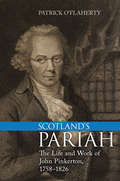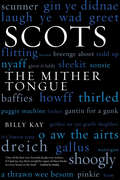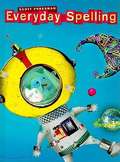- Table View
- List View
Scientific Style in English (River Publishers Series In Innovation And Change In Education Ser.)
by Marcelo Sampaio Alencar Thiago Tavares AlencarStyle is a distinctive manner of expression, in writing or speech. The wordevolved from Latin stilus, an instrument for writing, marking, or incising,such as something used by the ancients in writing on clay or waxed tablets.It is the way in which something is said or done, as distinguished fromits substance. Style is also a convention with respect to spelling, punctuation,capitalization, and typographic arrangement and display followed in writingor printing.Scientific Style in English aims to help students with the reading and writing of scientific and technical texts in English, with a particular focus on style, grammar and math. It can be used by students and professionals with basic or intermediate understanding of theEnglish language.Technical topics discussed in the book include: Scientific Style in English Mathematical Style in English Technical Style Stylistic Problems in English How to write Theses and Dissertations
Scientific Writing and Communication in Agriculture and Natural Resources
by P.K. Ramachandran Nair Vimala D. NairThe purpose of this book is to help early career professionals in agriculture and natural resources write their research papers for high-quality journals and present their results properly at professional meetings. Different fields have different conventions for writing style such that the authors of the book have found it difficult to recommend to young scientists in these fields a specific book or source material out of the several that are available as the "go to" guide. Writing a scientific paper is a tedious task even to experienced writers; but it is particularly so for the early career professionals such as students, trainees, scientists and scholars in agriculture and natural resources; the challenge is even more when their first language of communication is not English. This book is targeted mainly to that group.
Scientific and Medical Communication: A Guide for Effective Practice (ATTW Series in Technical and Professional Communication)
by Scott A. MogullScientific and Medical Communication: A Guide for Effective Practice prepares readers to effectively communicate in professional scientific communities. The material in this book is firmly grounded in more than 500 published research findings and editorials by scientific writers, authors, and journal editors. Thus, this text provides the broadest and most comprehensive analysis of scientific writing. In addition, carefully selected and thoroughly annotated examples from the scientific and medical literature demonstrate the recommendations covered in the text. These real-world examples were carefully selected so that the scientific content can be understood by those without a detailed background in any particular scientific or medical field—thus clearly illustrating the content organization and writing style. This text will prepare individuals to write and edit scientific manuscripts, conference abstracts, posters, and press releases according to journal and professional standards. Readers will also learn to conduct effective searches of the scientific and medical literature, as well as proper citation practices.
Scientific and Technical Translation (Routledge Translation Guides)
by Maeve OlohanRoutledge Translation Guides cover the key translation text types and genres and equip translators and students of translation with the skills needed to translate them. Concise, accessible and written by leading authorities, they include examples from existing translations, activities, further reading suggestions and a glossary of key terms. Scientific and Technical Translation focuses on texts that are typically translated in scientific and technical domains, such as technical instructions, data sheets and brochures, patents, scientific research articles and abstracts, popular science press releases and news reports. In seven chapters, this practical textbook: Introduces readers to the typical contexts in which scientific and technical translators work; Shows how corpus resources can be used for terminological and phraseological research; Considers how translation technologies are employed in technical and scientific translation; Explains a range of technical and scientific genres and their translation. Including a wide range of relevant tasks and activities, examples from the most commonly taught language pairs and a glossary of key terms, this is the essential textbook for modules on scientific and technical translation and specialised translation.
Scientific and Technical Translation Explained: A Nuts and Bolts Guide for Beginners (Translation Practices Explained)
by Jody ByrneFrom microbiology to nuclear physics and chemistry to software engineering, scientific and technical translation is a complex activity that involves communicating specialized information on a variety of subjects across multiple languages. It requires expert linguistic knowledge and writing skills, combined with the ability to research and understand complex concepts and present them to a range of different audiences. Using a combination of interdisciplinary research, real-world examples drawn from professional practice and numerous learning activities, this introductory textbook equips the student with the knowledge and skills needed to get started in this exciting and challenging field. It examines the origins and history of scientific and technical translation, and the people, tools and processes involved in translating scientific and technical texts. Scientific and Technical Translation Explained provides an overview of the main features of scientific and technical discourse as well as the different types of documents produced. A series of detailed case studies highlight various translation challenges and introduce a range of strategies for dealing with them. A variety of resources and exercises are included to make learning effective and enjoyable. Additional resources and activities are available on Facebook.
Scientists Must Write: A Guide to Better Writing for Scientists, Engineers and Students
by Robert BarrassGood writing and communication skills are essential in many areas of science and engineering, to help observation, thinking and remembering, to organize work and to avoid stress. Written by a scientist for scientists, this book is much more than a textbook of English grammar – it is a valuable source of information for all aspects of writing in scientific and technical situations. The only book focusing on the ways in which writing is important to the scientific community, this book assists readers on: * how to write and choice of words* using numbers and illustrations* writing project reports, theses and papers for publication* giving a short talk or presentation. The new edition of Scientists Must Write has been fully revised and updated to take account of the changes in information and communications technology including word processing and information storage and retrieval; new appendices on punctuation, spelling and computers; and useful exercises to improve writing. This popular guide will be of great use to undergraduates, postgraduates, professional scientists and engineers.
Scoops: Behind the Scenes of the BBC's Most Shocking Interviews
by Sam McAlister&‘Riveting&’ Sunday Telegraph &‘Behind every great interview is a great booker – Sam McAlister is one of the unsung heroes of television news&’ Piers Morgan She is the woman who clinched the 2019 interview with Prince Andrew, described as &‘a plane crashing into an oil tanker, causing a tsunami, triggering a nuclear explosion&’. She is many things beside: the first in her family to go to university; a trained barrister; a single mum; a master of persuasion. In her former BBC colleagues&’ words, she was the &‘booker extraordinaire&’, responsible for many of Newsnight&’s exclusives over the past decade, including Stormy Daniels, Sean Spicer, Brigitte Höss, Steven Seagal, Mel Greig and Julian Assange. After 12 years producing content for Newsnight, McAlister reflects with candour on her experience, sharing not just the secrets of how the best news gets made, but also the changes to the BBC, the future of &‘mainstream media&’ in the age of clickbait and the role of power and privilege in shaping our media landscape. This is a backstage pass to the most unforgettable journalism of our times.
Score One for the Dancing Girl, and Other Selections from the 'Kimun ch'onghwa': A Story Collection from Nineteenth-century Korea
by Ross King James Scarth Gale Donguk Kim Si Nae ParkScore One for the Dancing Girl presents more than a hundred stories from an early-nineteenth-century collection of yadam stories, the Kimun ch'onghwa ("Compendium of Records of Hearsay"). Prose tales that feature historical people and places but may also include fantastical elements, the yadam stories in this volume feature ghosts and magic, courtesans and sex, and court politics. They constitute both an entertaining literary collection and a rich treasure trove of information about life in seventeenth and eighteenth-century Korea.The first volume in an ongoing series of translations of classic Korean literature by the Canadian missionary James Scarth Gale (1863-1937), Score One for the Dancing Girl includes the original literary Sinitic (hanmun) text and Gale's English translation. Both the hanmun and English are extensively annotated. Introductory essays by Ross King and Si Nae Park discuss the yadam genre, Gale's life and career, and the ways in which his background as a Christian missionary affected the translations.
Scoreboost for TABE Language, Level M
by New Readers PressStandard English Conventions Vocabulary Write Different Text Types
Scoreboost for TABE Level D Language
by New PressAligned to TABE 11/12, each workbook features targeted instruction in an easy-to-follow format: strategy, example, guided practice, independent practice, and TABE practice. Each workbook ends with a TABE practice test to ensure TABE-readiness.
Scoreboost for TABE Level D Reading
by New PressAligned to TABE 11/12, each workbook features targeted instruction in an easy-to-follow format: strategy, example, guided practice, independent practice, and TABE practice. Each workbook ends with a TABE practice test to ensure TABE-readiness.
Scoreboost for TABE Level M Reading
by New PressAligned to TABE 11/12, each workbook features targeted instruction in an easy-to-follow format: strategy, example, guided practice, independent practice, and TABE practice. Each workbook ends with a TABE practice test to ensure TABE-readiness.
Scoreboost for TABE Reading, Level E
by New Readers PressWord Recognition Main Ideas and Details Definitions, Features, Purpose, and Point of View Illustrations and Evidence
Scoreboost® for TABE Language, Level E (11&12)
by New Readers PressStandard English Conventions Vocabulary Write Different Text Types
Scores
by John CluteFor more than 50 years John Clute has been reviewing science fiction and fantasy. As Scores demonstrates, his devotion to the task of understanding the central literatures of our era has not slackened. There are jokes in Scores, and curses, and tirades, and apologies, and riffs; but every word of every review, in the end, is about how we understand the stories we tell about the world. Following on from his two previous books of collected reviews (Strokes and Look at the Evidence) this book collects reviews from a wide variety of sources, but mostly from Interzone, the New York Review of Science Fiction, and Science Fiction Weekly. Where it has seemed possible to do so without distorting contemporary responses to books, these reviews have been revised, sometimes extensively. 125 review articles, over 200 books reviewed in more than 214,000 words.
Scores
by John CluteFor nearly 40 years John Clute has been reviewing science fiction and fantasy. As Scores demonstrates, his devotion to the task of understanding the central literatures of our era has not slackened. There are jokes in Scores, and curses, and tirades, and apologies, and riffs; but every word of every review, in the end, is about how we understand the stories we tell about the world. Following on from his two previous books of collected reviews (Strokes and Look at the Evidence) this book collects reviews from a wide variety of sources, but mostly from Interzone, the New York Review of Science Fiction, and Science Fiction Weekly. Where it has seemed possible to do so without distorting contemporary responses to books, these reviews have been revised, sometimes extensively. 125 review articles, over 200 books reviewed in more than 214,000 words.
Scotch Verdict: The Real-Life Story That Inspired "The Children's Hour"
by Lillian FadermanIn 1810, a Scottish student named Jane Cumming accused her school mistresses, Jane Pirie and Marianne Woods, of having an affair in the presence of their students. Dame Helen Cumming Gordon, the wealthy and powerful grandmother of the accusing student, advised her friends to remove their daughters from the Drumsheugh boarding school. Within days, the institution was deserted and the two women were deprived of their livelihoods.Award-winning author Lillian Faderman recreates the events surrounding this notorious case, which became the basis for Lillian Hellman's famous play, The Children's Hour. Reconstructing the libel suit filed by Pirie and Woods—which resulted in a scotch verdict, or a verdict of inconclusive/not proven—Faderman builds a compelling narrative from court transcripts, judges' notes, witnesses' contradictory testimony, and the prejudices of the men presiding over the case. Her fascinating portrait documents the social, economic, and sexual pressures shaping the lives of nineteenth-century women and the issues of class and gender contributing to their marginalization.
Scotland Under Mary Stuart: An Account of Everyday Life (Routledge Library Editions: Scotland #1)
by Madeleine BinghamOriginally published in 1971, this book gives the real substance of Scotland at the time of Mary Queen of Scots. It describes in extensive and colourful detail the way people of all ranks of society lived, their homes, their food and amusements, the ways they earned their living, cared for the sick and punished offenders. Family life, religion, the structure and activities of the clans and the state of the arts are all discussed. The book gives a true picture of a disturbed and remote country in the sixteenth century – a picture of contrasts and contradictions, as Scotland at that time was a country in transition between the medievalism of the Roman Catholic Church and the new Scotland with a rising merchant class.
Scotland and the Fictions of Geography
by Penny FieldingFocusing on the relationship between England and Scotland and the interaction between history and geography, Penny Fielding explores how Scottish literature in the Romantic period was shaped by the understanding of place and space. This 2008 book examines geography as a form of regional, national and global definition, addressing national surveys, local stories, place-names and travel writing, and argues that the case of Scotland complicates the identification of Romanticism with the local. Fielding considers Scotland as 'North Britain' in a period when the North of Europe was becoming a strong cultural and political identity, and explores ways in which Scotland was both formative and disruptive of British national consciousness. Containing studies of Robert Burns, Walter Scott and James Hogg, as well as the lesser-known figures of Anne Grant and Margaret Chalmers, this study discusses an exceptionally broad range of historical, geographical, scientific, linguistic, antiquarian and political writing from throughout North Britain.
Scotland's Pariah
by Patrick O'FlahertyScotland's Pariah is the first book to examine the remarkable life of John Pinkerton: antiquarian, poet, forger, cartographer, historian, serial adulterer, bigamist, and religious skeptic. A pugnacious and persistent man of letters who knew and was admired by literary masters such as Edward Gibbon, Horace Walpole, and William Godwin, Pinkerton's life was full of personal and professional misadventures.Patrick O'Flaherty's biography presents an engrossing account of Pinkerton's life and works from his early years in Scotland to his Parisian exile, covering his major editorial, antiquarian, and geographic works. Examining Pinkerton's involvement in the London literary scene, his conflicted relationship with the rise of Celtic nationalism, and his response to early literary romanticism, Scotland's Pariah is a shrewd and compassionate evaluation of an astonishing literary life.
Scots: The Mither Tongue
by Billy KayScots: The Mither Tongue is a classic of contemporary Scottish culture and essential reading for those who care about their country's identity in the twenty-first century. It is a passionately written history of how the Scots have come to speak the way they do and has acted as a catalyst for radical changes in attitude towards the language. In this completely revised edition, Kay vigorously renews the social, cultural and political debate on Scotland's linguistic future, and argues convincingly for the necessity to retain and extend Scots if the nation is to hold on to its intrinsic values. Kay places Scots in an international context, comparing and contrasting it with other lesser-used European languages, while at home questioning the Scottish Executive's desire to pay anything more than lip service to this crucial part of our national identity. Language is central to people's existence, and this vivid account celebrates the survival of Scots in its various dialects, its literature and song. The mither tongue is a national treasure that thrives in many parts of the country and underpins the speech of everyone who calls themselves a Scot.
Scott Fitzgerald
by Andrew TurnbullBook description: Revealing and unusual, Scott Fitzgerald follows the fascinating life of one of America's most enduring authors, from his early years in St. Paul and at Princeton to New York in the twenties, the French Riviera, Baltimore, and finally Hollywood. Andrew Turnbull tells the story behind F. Scott Fitzgerald's This Side of Paradise, revised and finally published when he was twenty-four, making him instantly famous, and his tender love affair with Zelda Sayre, from their glittering early life to the years Zelda spent in and out of sanatoriums. A literary generation, too, comes alive, including Ernest Hemingway, Edmund Wilson, the Murphys, and Edith Wharton. Fitzgerald lived on Turnbull's family estate in Baltimore in the early 1930s and there befriended young Andrew, then age eleven. Turnbull's personal relationship with Fitzgerald and the hundreds of interviews with those who knew him elegantly capture the dramatic, tragic story of F. Scott and the glow and pathos of his flamboyant life.
Scott Foresman Everyday Spelling, Grade 6
by James Beers Ronald L. Cramer W. Dorsey HammondEveryday Spelling (©2008) components for Grade 6.
Scott Foresman Literature and Integrated Studies
by Carol Booth Olson Alan C. Purves Carlos E. CortésThe types of questions you will find in this book are shaping your response, analyzing the story and extending the ideas.
Scott Foresman Literature and Integrated Studies [Grade 8]
by Carol Booth Olson Alan C. Purves Carlos E. Cortes Judith A. Brough Edward N. BrazeeEnglish literature textbook.
